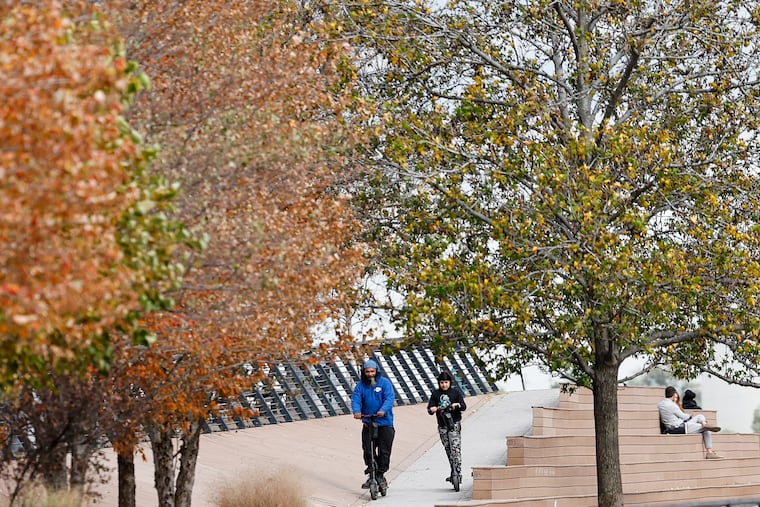Philly is closing in on century-old records for dryness. What’s behind the lack of rain?
It's possible that October will finish with 0.00 inches of rain, a record that could never be broken.

While not quite in a league with the aurora or the appearance of a once-every-80,000-years comet, Philly has an excellent chance of breaking rainless records that have stood since the administrations of Ulysses S. Grant and Calvin Coolidge.
It has been 23 days since a drop of rain was observed officially at Philadelphia International Airport, and the latest forecasts covering the period through Election Day aren’t seeing much, if any, precipitation.
» READ MORE: Philly sets a daily temperature record with a high of 84, almost 20 degrees above normal
The standing record for most consecutive days without rain is 29, set in October and November in 1874, a few years after Grant signed a bill creating a national weather service and Philly began tracking weather data. This month also has a shot at dethroning the all-time October dryness champs, 1924 and 1963, in which all of 0.09 inches was measured officially in each of those months. Those also remain the driest months on record — but perhaps not for long.
Combined, September and October in all likelihood will constitute the driest two-month period on record.
Why is it not raining in Philly?
Rain-deprived Octobers are nothing new around here. “This typically is a dry time of year for a lot of areas,” said Frank Pereira, a senior branch forecaster at the government’s Weather Prediction Center, in College Park, Md.
But aridity is another matter. In fact, in recent days the Philly air has been as dry as it is in Phoenix, which has had more rain this month — a trace — than Philadelphia.
A sequence of fronts have moved through the Northeast and Mid-Atlantic regions, but in terms of producing rain, in effect they’ve been trying to wring out moisture from dry rags.
Rain-repelling high pressure — heavier, sinking air that stifles clouds and has bestowed a remarkable run of relentlessly blue skies over the Philly region, along with a spectacular display of moonlight last week — has dominated the weather agenda in Philadelphia and in much of the East.
“That’s pretty much the pattern we’re stuck in now,” said Pereira. “It kind of looks like it’s going to remain that way.”
Perhaps ironically, a recent run of tropical storms also has been a player in the dryness, meteorologists say. In part, the sinking air that has cut off moisture from the Philly region has been a response to the rain-bearing rising air associated with those storms.
As for possible connections to climate change, drought conditions are expected to become more common as temperatures rise. However, the Intergovernmental Panel on Climate Change has said that warming has not yet reached a level at which the Eastern United States “would be affected by increases in agricultural and ecological droughts.”
Asking residents to conserve water, New Jersey on Thursday declared a statewide drought watch, a step Pennsylvania has not yet taken. The Philly region hasn’t had a significant drought in over 20 years.
Conditions around here have been desertlike, with daytime humidities similar to those of Phoenix. One symptom of the dryness is in the differences between overnight lows and daytime highs in Philly. With rapid cooling at night, the spreads have been averaging about 25 degrees since Oct. 10.
The clear skies after the ever-earlier sunsets have allowed the daytime warmth to escape into space efficiently, especially in areas away from the Philly urban heat island, said Ray Martin, a lead meteorologist at the National Weather Service office in Mount Holly. In Millville, for example, the day-night differences have been on the order of 30 to 40 degrees.
Brush fires are likely to be a growing hazard, and the weather service is warning that the dry spell eventually could lead to widespread drought impact.
But in the meantime, the aridity has had some obvious pluses. Just ask the campers and hikers. Foliage experts say the cool nights have been great for the fall colors. (Eat your heart out, Phoenix.)
And while the last two days have been especially warm — 81 degrees Monday and a record-breaking 84 on Tuesday — the higher temperatures that may have been uncomfortable for some have lasted only a few hours, said Dave Dombek, senior meteorologist with AccuWeather Inc. On July 6, by contrast, the temperature never got below 80 degrees on a day when it went up to 97.
In addition, the region is fortunate that nature has shut off the faucet at a time when the foliage is getting ready to call it a season, said Dombek
If a dry spell like this had parched the region in summer, when water demands are higher for humans and vegetation, “Man, we would be in serious trouble,” he said.
Is it ever going to rain again in Philly?
The Climate Prediction Center has odds favoring below-normal precipitation through Election Day.
In the shorter term, not a drop is in the forecast through Monday. Thus, it appears that Philly is on target to break that consecutive-day rainless record.
And it’s entirely possible that October will finish at 0.00.
That would be a record that could never be broken.